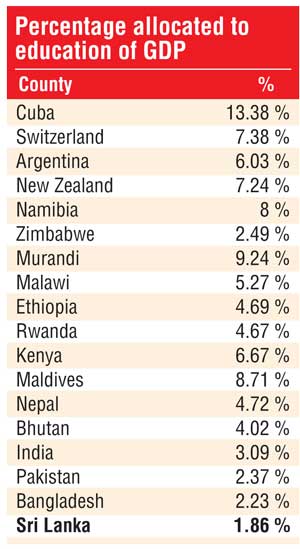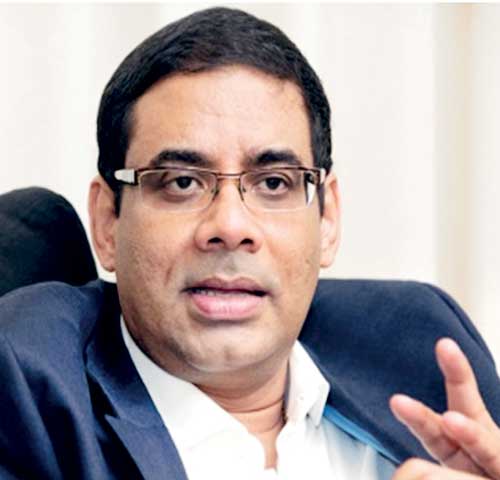Friday Mar 14, 2025
Friday Mar 14, 2025
Saturday, 27 May 2017 01:05 - - {{hitsCtrl.values.hits}}
 National Human Resources Development Council of Sri Lanka Chairman Dinesh Weerakkody points out that an important factor on which the success of Sri Lanka’s economic development plan hinges on its availability of skilled and employable workforce to support the growth. Weerakkody, while outlining some of the human capital development goals and objectives of the current Government in an interview, points out the need for effective leadership at Cabinet level to address the challenge and also the need for effective coordination among all the ministries and agencies tasked to expand the supply of skilled and employable workers. Following are excerpts:
National Human Resources Development Council of Sri Lanka Chairman Dinesh Weerakkody points out that an important factor on which the success of Sri Lanka’s economic development plan hinges on its availability of skilled and employable workforce to support the growth. Weerakkody, while outlining some of the human capital development goals and objectives of the current Government in an interview, points out the need for effective leadership at Cabinet level to address the challenge and also the need for effective coordination among all the ministries and agencies tasked to expand the supply of skilled and employable workers. Following are excerpts:
By Nuwan Ranawaka
Q: How do you address job readiness at a national level?
A: To improve the skill availability, we need to firstly improve the interface with industry. It is important to include the changing needs of industry in the Skill Development Program. Therefore it is important to have industry feedback on a consistent basis to ensure that all interventions both public and private can supply a job ready workforce to the critical growth sectors of the economy. Countries that are blessed with strong growth in the working age population and doing the best job of bringing fresh talent into the labour pool will continue to attract the most amount of FDI.

Q: You have been talking of a new concept for human resource development – the concept towards a future ready workforce?
A: Simply put, it is anticipating and building competencies for future needs, to realise this goal in addition to the resources, we need to have a sustained dialogue between employers and trainers, coordination across Government institutions, proper labour market information and good employment services. We still don’t have a clear national agenda to put all this together. The time for talk is over, it is time for action because our neighbours are working smart to boost the size of their labour pools. For a nation’s economic prospects, the key demographic question is whether the talent pool is growing.
Q: You mentioned that Sri Lanka needs a national agenda; don’t we have one now?
A: We have something, but what we need is a clear national vision for labour, backed by funding, realistic targets, an implementation strategy and all the Government and private agencies working together to achieve it. We need greater private sector participation to address the education and skills gaps in the country. Currently most groups are still working in isolation duplicating the work of each other, though it has improved lately. A more holistic response to human resources planning that draws together the various government agencies, employer organisations and providers of education and training is needed, that would enable reforms to be achieved with clear statement of responsibility shared among Government, educators, the social partners and the private sector.
Q: Is there an appreciation for this thinking?
A: Many policymakers are aware that if we are to gain or maintain our status as a middle-income country, we must produce the higher value-added, higher quality goods and services that can yield higher wages and profits. To do this we need a skilled workforce, and to get there we need an education and training system that adequately prepares young people to enter the labour market, also the adult workers, school drop-outs, workers in the informal economy and disadvantage groups.
Q: So what are the skills challenges that we are now faced with as a nation?
A: Firstly, the skills mismatch. Skills obtained through training and those required by the job often do not match, resulting in skills shortages in some areas and simultaneously a surplus of workers with skills that are not in demand, contributing to unemployment and underemployment. Secondly, the limited involvement of all the key partners. In Sri Lanka, we lack the active participation and coordination between the State, employers and worker organisations that is very essential to ensure the provision of relevant and appropriate training. Thirdly, poor quality and relevance of training. Weak quality assurance, too few or poorly paid trainers, poor working conditions for trainers, and outdated skills, curricula, training materials and methods, all inhibit the quality of training. Limited labour market information and inability to translate such information into improved training interventions undermines relevance.
Q: What can be done at a Government level to accelerate skills acquisition?
A: The skill ecosystem in Sri Lanka is currently undergoing major reforms as we embark on our journey to become a knowledge economy in the next 10 years. In the last two years, the Government has taken a host of initiatives to channel the efforts and provide impetus to the skill development ecosystem. For example, like the ‘Skill India’ campaign has an aggressive aim of training 400 million people on different skills, we must also have an initiative to get our work force job and future ready. For this to work the policy framework for skill development has to be made to align with all key national initiatives to increase economic growth and like in Malaysia the Prime Minister himself must drive this, not his office.
Q: Are there any specific policy interventions planned for 2017 and beyond?
A: To address some of these challenges the Government has proposed a new Education and Employment Act under which a new Human Resources Development Agency and Employment Relations Council will play a key role in steering key initiatives with stakeholder collaboration. The new Act will take forward the Government’s plans to strengthen the education to employment continuum. We need to push this through like yesterday.
Q: How do you deal with the shortage of labour we have?
A: The shortage we are having is at blue collar level and also pink collar workers. The construction and tourism industry is starved of people at these levels. This is despite Sri Lanka having over 400,000 unemployed people and 1.2 million trishaw drivers. We cannot allow development to suffer due to a labour shortage. We need to go out and get them from oversees till we grow our labour pool. Many developed countries did that very well and are still doing it.
Q: Finally, as an HR expert you have at company level seen the challenges in hiring people with the right skills. What steps are required at enterprise level to address these issue?
A: Many employers say to me they have difficulty filling positions. Some of the complaints about skill shortages simply could be that employers can’t get top candidates to join their companies because they do not have a solid reputation as an employer of choice or the wages they offer is not competitive. Then that becomes essentially an attraction problem, not a skill shortage. A skill shortage to me would be when employers cannot find candidates at market-clearing wages. The solution lies in education and training. As I said before, young people should be trained in areas where jobs are plenty. There are probably many jobs that go elsewhere because people don’t have the expertise. Therefore, post-secondary education should become more affordable so that people have the opportunity to move into fields were skills are in high demand. The pressure to attract our skilled workers by the emerging world will continue, hence we need to deepen our talent pools.
(Nuwan Ranawaka is a graduate in business administration and works for a research company.)
Discover Kapruka, the leading online shopping platform in Sri Lanka, where you can conveniently send Gifts and Flowers to your loved ones for any event including Valentine ’s Day. Explore a wide range of popular Shopping Categories on Kapruka, including Toys, Groceries, Electronics, Birthday Cakes, Fruits, Chocolates, Flower Bouquets, Clothing, Watches, Lingerie, Gift Sets and Jewellery. Also if you’re interested in selling with Kapruka, Partner Central by Kapruka is the best solution to start with. Moreover, through Kapruka Global Shop, you can also enjoy the convenience of purchasing products from renowned platforms like Amazon and eBay and have them delivered to Sri Lanka.
Discover Kapruka, the leading online shopping platform in Sri Lanka, where you can conveniently send Gifts and Flowers to your loved ones for any event including Valentine ’s Day. Explore a wide range of popular Shopping Categories on Kapruka, including Toys, Groceries, Electronics, Birthday Cakes, Fruits, Chocolates, Flower Bouquets, Clothing, Watches, Lingerie, Gift Sets and Jewellery. Also if you’re interested in selling with Kapruka, Partner Central by Kapruka is the best solution to start with. Moreover, through Kapruka Global Shop, you can also enjoy the convenience of purchasing products from renowned platforms like Amazon and eBay and have them delivered to Sri Lanka.